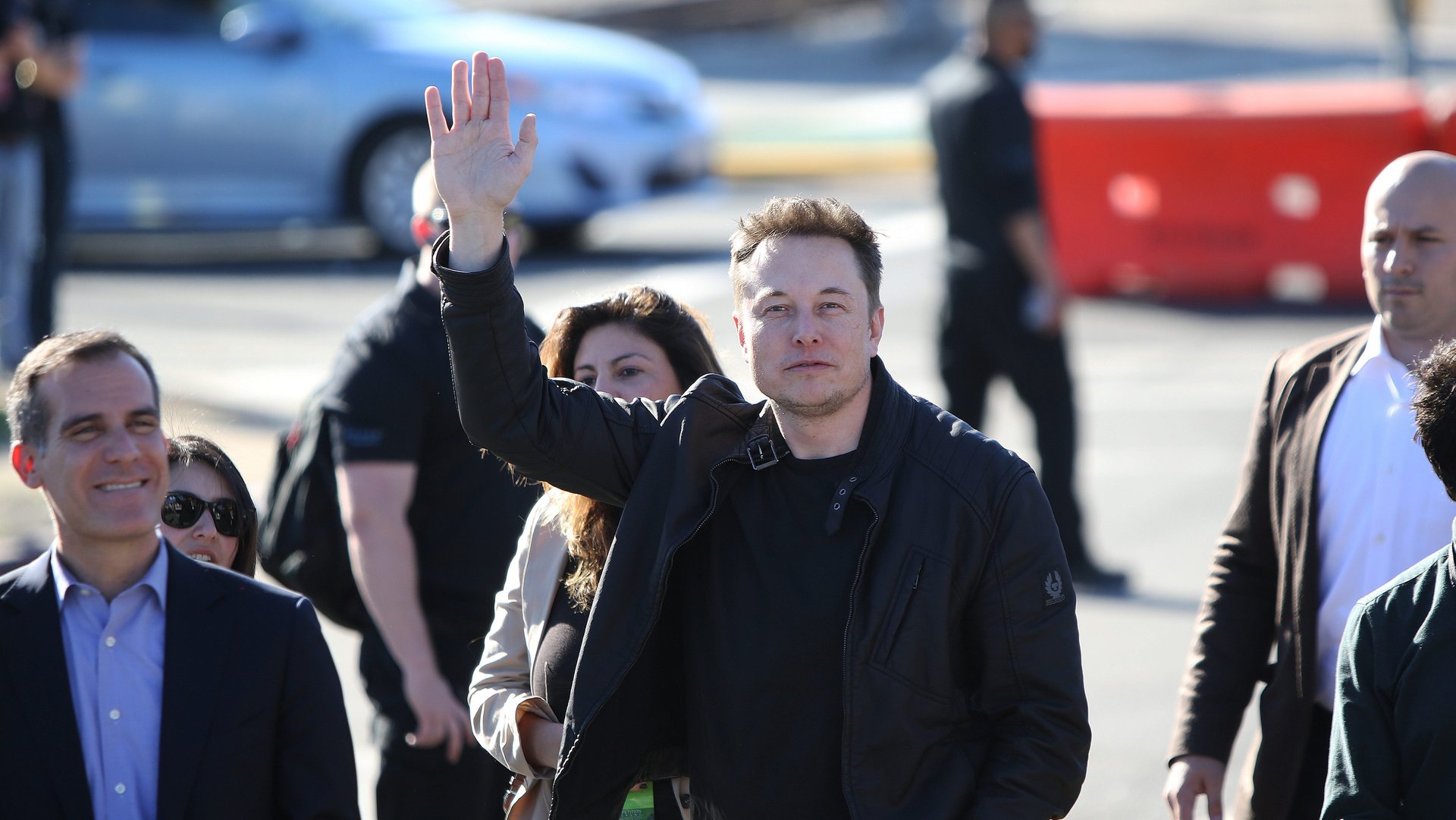All the highlights (and quips) from Tesla’s annual shareholder meeting
Tesla CEO Elon Musk likes to use his annual meetings to banter with fans in the audience when he isn’t batting away challenges from shareholders. At the 2017 meeting today (June 6), fresh off a streak of stock success dating back to Dec. 2016 and with shares continually hitting new heights, Musk was in a good mood answering questions submitted over Twitter and musing about the future of electric transport.


Tesla CEO Elon Musk likes to use his annual meetings to banter with fans in the audience when he isn’t batting away challenges from shareholders. At the 2017 meeting today (June 6), fresh off a streak of stock success dating back to Dec. 2016 and with shares continually hitting new heights, Musk was in a good mood answering questions submitted over Twitter and musing about the future of electric transport.
Tesla’s management also successfully fended off institutional investors’ attempt to make board directors face annual elections, rather than serving staggered, three-year terms. The motion, designed to create a more independent board, was rejected. Here are the highlight from Musk’s discussion:
Go, go superchargers
Tesla is making a big push to expand its supercharger network of fast-charging stations—capable of adding enough charge to drive 170 miles in 30 minute—for Tesla owners. The company plans to double the number of superchargers this year to 10,000 by end of 2017, and add at least 50% more the following year. Tesla says it’s adding “amenities” to certain supercharger stations, although did not give specifics. City dwellers, especially those without access to chargers at home, can expect easier access to superchargers, as Tesla broadens its focus from serving long-distance drivers.
Autopilot
Tesla is rolling out a new version of its vehicles (“Hardware 2”) after deciding to dump the Mobileye sensors and algorithms used in earlier models. Customers have complained about the unpleasant performance of the semi-autonomous Autopilot software in the new vehicles, although Musk said a software update due out this month should solve many of those problems, and that the software will continue to improve. Musk also reaffirmed Tesla’s goal of driving a fully autonomous vehicle from a parking lot in California to New York City without touching the controls at any point along the way.
The Model 3 is almost here
Tesla is racing to ramp up overall production to a pace of 500,00 cars per year by 2018 up from about 50,000 last year.
Musk said Tesla will deliver the first Model 3 production vehicle next month. The company will offer just one configuration of the Model 3: a single-motor model rather than a dual-motor version optimized for both city and highway driving that’s available on the Model S and Model X. Musk said he wants to avoid the painful delays and manufacturing complications that stymied production of the tricked-out Model X SUV, which he compared to a Fabergé egg: “We created something great that will never be made again, and perhaps shouldn’t be.”
The Model Y and Semi aren’t far behind. But no electric plane, yet.
The Model Y will be here by 2019, Musk said. Tesla is expected to roll out the electric compact SUV featuring the company’s “Falcon Wing” doors and an entirely new chassis. Musk said it would be a mistake not to design a entirely new car given the opportunities to optimize the vehicle, and design more efficient manufacturing lines. Tesla will build a new factory for the Model Y, while batteries and other components will be supplied by the existing gigafactory in Nevada.
The Tesla Semi is also under development with input from major freight companies. Musk claimed the firms would buy as many trucks as Tesla could build. The Semi should make its debut this September, although it’s still not clear how the vehicle can supply enough energy to haul long-distance cargo (one estimate put the necessary batteries at half the weight of the truck itself).
There are “no plans” to have an electric plane, but it’s not “inconceivable,” Musk said, adding that he expects battery energy density would need to rise 25% to 500 watts per kilogram before it would become feasible.
Gigafactories, everywhere
Tesla plans to build gigafactories to produce both vehicles and batteries in “three locations” in the coming years, one of them for the Model Y, although Musk declined to name locations or specifics for the plants. The company has one existing gigafactory that it co-runs with Panasonic in the Nevada desert, expected to be capable of churning out 35 GWh of cells per year by 2018.
In the past, Musk has claimed that just “four or five” factories could equal the capacity of all of Ford’s total manufacturing plants, which roll out over 6 million vehicles per year. At the 2017 annual meeting, he upped those plans: he said Tesla will “build 10 gigafactories, or as many as 20” in the future.
Music mystery
Musk complained about the quality of today’s music algorithms and playlist quality, and promised to make an announcement about a new feature or service later this year to solve the problem. “It’s gonna be the music you want to listen to,” he said.
How Musk spends his time
In answer to a Twitter question, the CEO said his splits more than 90% of his time between Space X and the “drama magnet” Tesla. The rest of his working hours go to Neuralink (3-5%), The Boring Company (2%) and Open AI (~2% percent).
After work? No interest in sports, Musk said. “I listen to music in the car,” he said, struggling to recall other leisure activities. “I do watch movies, although less these days,” he said. “Hang out with kids, see friends, normal stuff. Sometimes go crazy on Twitter. But usually it’s work more.”